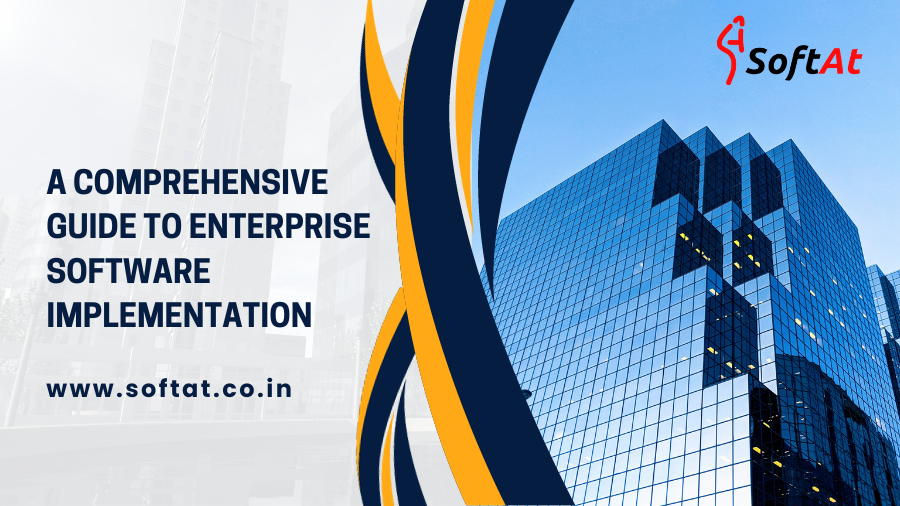Introduction
Embarking on the journey of enterprise software implementation can be a game-changer for businesses. In this guide, we will delve into the intricacies of this transformative process, exploring the key elements that contribute to a successful implementation.
The ERP implementation process includes the following phases:
- Discovery and planning
- Integration costs budgeting
- Design
- Development
- Testing
- Deployment
- Maintenance
Understanding Enterprise Software

Before diving into implementation, let’s demystify enterprise software. It serves as the digital backbone of organizations, streamlining processes, enhancing efficiency, and providing a centralized platform for diverse functions.
A Guide to Migration ECC to S4 HANA
The Imperative of Planning
- Planning
The first step in any enterprise software implementation is to develop a plan. This plan should include the following:
- Goals and objectives: What does the organization want to achieve with the new software?
- Requirements: What features and functionality must the new software have?
- Budget: How much money is available for the implementation project?
- Timeline: When does the organization want to have the new software implemented?
Choosing the Right Software
Not all enterprise software is created equal. The choice of software should align with the unique requirements of the business. Whether it’s ERP, CRM, or HCM, selecting the right tool sets the stage for a seamless integration into daily operations.
- Software selection
Once the plan is in place, the next step is to select the right software for the organization. This involves evaluating different software solutions and comparing their features, functionality, and price.
When selecting enterprise software, it is important to consider the following factors:
- Business needs: Does the software meet the specific needs of the organization?
- Scalability: Can the software scale to meet the future needs of the organization?
- Ease of use: Is the software easy to use and learn?
- Vendor support: Does the vendor offer good support for the software?
- Implementation
Once the software has been selected, the next step is to implement it. This process typically involves the following steps:
- Data migration: Migrating data from the old system to the new system.
- Configuration: Configuring the software to meet the specific needs of the organization.
- Testing: Testing the software to ensure that it is working properly.
- Training: Training employees on how to use the new software.
- Post-implementation
Once the software has been implemented, it is important to monitor its performance and make adjustments as needed. This includes tracking the system’s usage, identifying and resolving any problems, and providing ongoing training to employees.
Building a Skilled Team
Success lies in the hands of those executing the implementation. Assembling a skilled implementation team with diverse expertise ensures that each aspect, from technical configurations to end-user training, is handled with precision.
Customization for Business Harmony
Customization is not a luxury; it’s a necessity. Tailoring the software to match the specific workflows and needs of the organization enhances user adoption and ensures that the software aligns seamlessly with existing processes.
Data Migration: A Delicate Dance
Moving data from legacy systems to the new software requires finesse. Data migration is a delicate dance that demands meticulous planning and execution to prevent disruptions and data integrity issues.
User Training and Adoption
The success of any enterprise software hinges on user training and adoption. A well-designed training program ensures that end-users are not only familiar with the new system but also confident in using it effectively.
Navigating Enterprise Resource Planning (ERP) System
Continuous Evaluation and Optimization
The journey doesn’t end with implementation. Continuous evaluation and optimization are crucial. Regular assessments, feedback loops, and software updates keep the system aligned with evolving business needs.
Mitigating Risks
No implementation is without risks. Identifying potential risks early on and developing a comprehensive risk mitigation strategy ensures that any challenges can be addressed proactively, minimizing the impact on operations.
Leveraging Support and Documentation
A robust support system and comprehensive documentation are lifelines post-implementation. Quick access to support and clear documentation empowers users to troubleshoot issues independently, reducing downtime.
Tips for successful enterprise software implementation
Here are some tips for successful enterprise software implementation:
- Get buy-in from stakeholders: It is important to get buy-in from all stakeholders, including executives, employees, and customers, early in the implementation process. This will help to ensure that everyone is on the same page and that the implementation is supported by the entire organization.
- Create a detailed project plan: The project plan should include all of the tasks that need to be completed, as well as the timeline and budget for the project.
- Communicate regularly with stakeholders: It is important to communicate regularly with stakeholders throughout the implementation process. This will help to keep everyone informed of the progress of the project and to address any concerns that may arise.
- Test the software thoroughly: It is important to test the software thoroughly before it is implemented. This will help to identify and resolve any problems before they impact the organization’s operations.
- Provide training to employees: It is important to provide training to employees on how to use the new software. This will help to ensure that employees are able to use the software effectively and efficiently.
What is the future of the ERP industry ?
Conclusion
In conclusion, enterprise software implementation is not just a technological upgrade; it’s a strategic move towards operational excellence. From meticulous planning to continuous evaluation, each step plays a vital role in ensuring a smooth and successful implementation. By mastering the art of implementation, businesses can unlock the full potential of their chosen enterprise software, paving the way for sustained growth and success.





